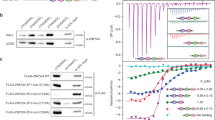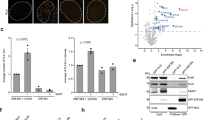Abstract
The Ku heterodimer, comprised of Ku70 and Ku80 subunits, is a conserved complex involved in nonhomologous end-joining (NHEJ). However, it also functions in maintenance of telomeres, chromosome termini normally resistant to end-joining events. To elucidate the spatial organization of these functions, we rationally guided Ku mutagenesis in yeast with real-valued evolutionary trace (rvET). This revealed two ancestrally related α-helices: one on the Ku70 surface that is required in yeast for NHEJ, and a second on the Ku80 surface that is required in yeast for telomeric heterochromatin formation. When bound to a DNA end, the surface containing the NHEJ-specific Ku70 helix is oriented toward the DNA terminus, whereas the surface containing the telomeric function–specific Ku80 helix faces inward, toward telomeric chromatin, when bound to a telomere. We propose a 'two-face' model for Ku and that divergent evolution of these faces allowed Ku's dual role in NHEJ and telomere maintenance.
This is a preview of subscription content, access via your institution
Access options
Subscribe to this journal
Receive 12 print issues and online access
$189.00 per year
only $15.75 per issue
Buy this article
- Purchase on Springer Link
- Instant access to full article PDF
Prices may be subject to local taxes which are calculated during checkout





Similar content being viewed by others
Accession codes
References
van Steensel, B., Smogorzewska, A. & de Lange, T. TRF2 protects human telomeres from end-to-end fusions. Cell 92, 401–413 (1998).
d'Adda di Fagagna, F., Teo, S.H. & Jackson, S.P. Functional links between telomeres and proteins of the DNA-damage response. Genes Dev. 18, 1781–1799 (2004).
Viscardi, V., Clerici, M., Cartagena-Lirola, H. & Longhese, M.P. Telomeres and DNA damage checkpoints. Biochimie 87, 613–624 (2005).
Riha, K., Heacock, M.L. & Shippen, D.E. The role of the nonhomologous end-Joining DNA double-strand break repair pathway in telomere biology. Annu. Rev. Genet. 40, 237–277 (2006).
Miyoshi, T., Sadaie, M., Kanoh, J. & Ishikawa, F. Telomeric DNA ends are essential for the localization of Ku at telomeres in fission yeast. J. Biol. Chem. 278, 1924–1931 (2003).
Riha, K., Watson, J.M., Parkey, J. & Shippen, D.E. Telomere length deregulation and enhanced sensitivity to genotoxic stress in Arabidopsis mutants deficient in Ku70. EMBO J. 21, 2819–2826 (2002).
Hsu, H.L., Gilley, D., Blackburn, E.H. & Chen, D.J. Ku is associated with the telomere in mammals. Proc. Natl. Acad. Sci. USA 96, 12454–12458 (1999).
Gravel, S., Larrivee, M., Labrecque, P. & Wellinger, R.J. Yeast Ku as a regulator of chromosomal DNA end structure. Science 280, 741–745 (1998).
Celli, G.B., Denchi, E.L. & de Lange, T. Ku70 stimulates fusion of dysfunctional telomeres yet protects chromosome ends from homologous recombination. Nat. Cell Biol. 8, 885–890 (2006).
Espejel, S. et al. Mammalian Ku86 mediates chromosomal fusions and apoptosis caused by critically short telomeres. EMBO J. 21, 2207–2219 (2002).
Ferreira, M.G. & Cooper, J.P. The fission yeast Taz1 protein protects chromosomes from Ku-dependent end-to-end fusions. Mol. Cell 7, 55–63 (2001).
Fisher, T.S., Taggart, A.K. & Zakian, V.A. Cell cycle-dependent regulation of yeast telomerase by Ku. Nat. Struct. Mol. Biol. 11, 1198–1205 (2004).
Porter, S.E., Greenwell, P.W., Ritchie, K.B. & Petes, T.D. The DNA-binding protein Hdf1p (a putative Ku homologue) is required for maintaining normal telomere length in Saccharomyces cerevisiae. Nucleic Acids Res. 24, 582–585 (1996).
Stellwagen, A.E., Haimberger, Z.W., Veatch, J.R. & Gottschling, D.E. Ku interacts with telomerase RNA to promote telomere addition at native and broken chromosome ends. Genes Dev. 17, 2384–2395 (2003).
Nugent, C.I. et al. Telomere maintenance is dependent on activities required for end repair of double-strand breaks. Curr. Biol. 8, 657–660 (1998).
Polotnianka, R.M., Li, J. & Lustig, A.J. The yeast Ku heterodimer is essential for protection of the telomere against nucleolytic and recombinational activities. Curr. Biol. 8, 831–834 (1998).
Maringele, L. & Lydall, D. ExoI-dependent single-stranded DNA at telomeres activates subsets of DNA damage and spindle checkpoint pathways in budding yeast yku70Δ mutants. Genes Dev. 16, 1919–1933 (2002).
Boulton, S.J. & Jackson, S.P. Components of the Ku-dependent non-homologous end-joining pathway are involved in telomeric length maintenance and telomeric silencing. EMBO J. 17, 1819–1828 (1998).
Laroche, T. et al. Mutation of yeast Ku genes disrupts the subnuclear organization of telomeres. Curr. Biol. 8, 653–656 (1998).
Cosgrove, A.J., Nieduszynski, C.A. & Donaldson, A.D. Ku complex controls the replication time of DNA in telomere regions. Genes Dev. 16, 2485–2490 (2002).
Palmbos, P.L., Daley, J.M. & Wilson, T.E. Mutations of the Yku80 C terminus and Xrs2 FHA domain specifically block yeast nonhomologous end joining. Mol. Cell. Biol. 25, 10782–10790 (2005).
Bertuch, A.A. & Lundblad, V. The Ku heterodimer performs separable activities at double strand breaks and chromosome termini. Mol. Cell. Biol. 23, 8202–8215 (2003).
Walker, J.R., Corpina, R.A. & Goldberg, J. Structure of the Ku heterodimer bound to DNA and its implications for double-strand break repair. Nature 412, 607–614 (2001).
Rivera-Calzada, A., Spagnolo, L., Pearl, L.H. & Llorca, O. Structural model of full-length human Ku70-Ku80 heterodimer and its recognition of DNA and DNA-PKcs. EMBO Rep. 8, 56–62 (2007).
Yoo, S., Kimzey, A. & Dynan, W.S. Photocross-linking of an oriented DNA repair complex. Ku bound at a single DNA end. J. Biol. Chem. 274, 20034–20039 (1999).
Bianchi, A. & de Lange, T. Ku binds telomeric DNA in vitro. J. Biol. Chem. 274, 21223–21227 (1999).
Daley, J.M., Palmbos, P.L., Wu, D. & Wilson, T.E. Nonhomologous end joining in yeast. Annu. Rev. Genet. 39, 431–451 (2005).
Valdar, W.S. Scoring residue conservation. Proteins 48, 227–241 (2002).
Mihalek, I., Res, I. & Lichtarge, O. A family of evolution-entropy hybrid methods for ranking protein residues by importance. J. Mol. Biol. 336, 1265–1282 (2004).
Madabushi, S. et al. Structural clusters of evolutionary trace residues are statistically significant and common in proteins. J. Mol. Biol. 316, 139–154 (2002).
Yao, H. et al. An accurate, sensitive, and scalable method to identify functional sites in protein structures. J. Mol. Biol. 326, 255–261 (2003).
Lee, S.E., Paques, F., Sylvan, J. & Haber, J.E. Role of yeast SIR genes and mating type in directing DNA double-strand breaks to homologous and non-homologous repair paths. Curr. Biol. 9, 767–770 (1999).
Taddei, A., Hediger, F., Neumann, F.R., Bauer, C. & Gasser, S.M. Separation of silencing from perinuclear anchoring functions in yeast Ku80, Sir4 and Esc1 proteins. EMBO J. 23, 1301–1312 (2004).
Chothia, C. The nature of the accessible and buried surfaces in proteins. J. Mol. Biol. 105, 1–12 (1976).
Mishra, K. & Shore, D. Yeast Ku protein plays a direct role in telomeric silencing and counteracts inhibition by rif proteins. Curr. Biol. 9, 1123–1126 (1999).
Boulton, S.J. & Jackson, S.P. Saccharomyces cerevisiae Ku70 potentiates illegitimate DNA double-strand break repair and serves as a barrier to error-prone DNA repair pathways. EMBO J. 15, 5093–5103 (1996).
Gell, D. & Jackson, S.P. Mapping of protein-protein interactions within the DNA-dependent protein kinase complex. Nucleic Acids Res. 27, 3494–3502 (1999).
Driller, L. et al. A short C-terminal domain of Yku70p is essential for telomere maintenance. J. Biol. Chem. 275, 24921–24927 (2000).
Song, K., Jung, D., Jung, Y., Lee, S.G. & Lee, I. Interaction of human Ku70 with TRF2. FEBS Lett. 481, 81–85 (2000).
Bowater, R. & Doherty, A.J. Making ends meet: repairing breaks in bacterial DNA by non-homologous end-joining. PLoS Genet. 2, e8 (2006).
Doherty, A.J., Jackson, S.P. & Weller, G.R. Identification of bacterial homologues of the Ku DNA repair proteins. FEBS Lett. 500, 186–188 (2001).
Manolis, K.G. et al. Novel functional requirements for non-homologous DNA end joining in Schizosaccharomyces pombe. EMBO J. 20, 210–221 (2001).
Shenoy, S.K. et al. beta-arrestin-dependent, G protein-independent ERK1/2 activation by the beta2 adrenergic receptor. J. Biol. Chem. 281, 1261–1273 (2006).
Sowa, M.E. et al. Prediction and confirmation of a site critical for effector regulation of RGS domain activity. Nat. Struct. Biol. 8, 234–237 (2001).
Martinez, J.J., Seveau, S., Veiga, E., Matsuyama, S. & Cossart, P. Ku70, a component of DNA-dependent protein kinase, is a mammalian receptor for Rickettsia conorii. Cell 123, 1013–1023 (2005).
Sawada, M. et al. Ku70 suppresses the apoptotic translocation of Bax to mitochondria. Nat. Cell Biol. 5, 320–329 (2003).
Thompson, J.D., Higgins, D.G. & Gibson, T.J. CLUSTAL W: improving the sensitivity of progressive multiple sequence alignment through sequence weighting, position-specific gap penalties and weight matrix choice. Nucleic Acids Res. 22, 4673–4680 (1994).
Waterman, M.S. Introduction to Computational Biology (Chapman & Hall/CRC Press, Boca Raton, Florida, USA, 2000).
Kunkel, T.A., Roberts, J.D. & Zakour, R.A. Rapid and efficient site-specific mutagenesis without phenotypic selection. Methods Enzymol. 154, 367–382 (1987).
Roy, R., Meier, B., McAinsh, A.D., Feldmann, H.M. & Jackson, S.P. Separation-of-function mutants of yeast Ku80 reveal a Yku80p-Sir4p interaction involved in telomeric silencing. J. Biol. Chem. 279, 86–94 (2004).
Acknowledgements
We thank J. Huang and D. Wuttke for critical reading of the manuscript, S. Almaguer, S. Haricharan and C. Williams for technical assistance and H. Feldmann (Universität Munchen), D. Gottschling (Fred Hutchinson Cancer Research Center), J. Haber (Brandeis University) and V. Lundblad (Salk Institute for Biological Studies) for strains and plasmids. This work was supported by US National Institutes of Health grant RO1-GM066099, US National Science Foundation grant DBI0547695 and the March of Dimes grant FY06-371 (O.L.), and by a gift from the Cyvia and Melvyn Wolff Family Foundation (A.A.B.). rvET analysis is available publicly through the Lichtarge Computational Biology Lab server (http://mammoth.bcm.tmc.edu/).
Author information
Authors and Affiliations
Contributions
A.R.-Z. was the first to propose using evolutionary trace to study the Ku heterodimer. He performed all of the experiments except for the telomeric single-stranded overhang analysis, and, together with A.A.B., conceived the experimental design and interpreted the data. I.M. performed the rvET analysis and contributed to data analysis. O.L. oversaw the rvET analysis and contributed to data analysis. A.A.B. performed the telomeric single-stranded overhang analysis and oversaw the entire project. All authors contributed to the preparation of the final manuscript.
Corresponding author
Ethics declarations
Competing interests
The authors declare no competing financial interests.
Supplementary information
Supplementary Fig. 1
Yku80 mutants with global telomere defects. (PDF 2695 kb)
Supplementary Fig. 2
G-tail analysis of yku80 α5 mutant strains. (PDF 927 kb)
Supplementary Table 1
Summary of Ku80 vWA-like cluster mutagenesis. (PDF 91 kb)
Supplementary Table 2
Summary of Ku70 vWA-like cluster mutagenesis. (PDF 68 kb)
Supplementary Table 3
Yeast strains. (PDF 95 kb)
Supplementary Table 4
Plasmids. (PDF 74 kb)
Rights and permissions
About this article
Cite this article
Ribes-Zamora, A., Mihalek, I., Lichtarge, O. et al. Distinct faces of the Ku heterodimer mediate DNA repair and telomeric functions. Nat Struct Mol Biol 14, 301–307 (2007). https://doi.org/10.1038/nsmb1214
Received:
Accepted:
Published:
Issue Date:
DOI: https://doi.org/10.1038/nsmb1214
This article is cited by
-
The Ku complex: recent advances and emerging roles outside of non-homologous end-joining
Cellular and Molecular Life Sciences (2021)
-
DNA–dependent protein kinase in telomere maintenance and protection
Cellular & Molecular Biology Letters (2020)
-
Loss of Ku’s DNA end binding activity affects telomere length via destabilizing telomere-bound Est1 rather than altering TLC1 homeostasis
Scientific Reports (2019)
-
Integrating metabolic modeling and population heterogeneity analysis into optimizing recombinant protein production by Komagataella (Pichia) pastoris
Applied Microbiology and Biotechnology (2018)
-
Improving the catalytic activity of isopentenyl phosphate kinase through protein coevolution analysis
Scientific Reports (2016)



